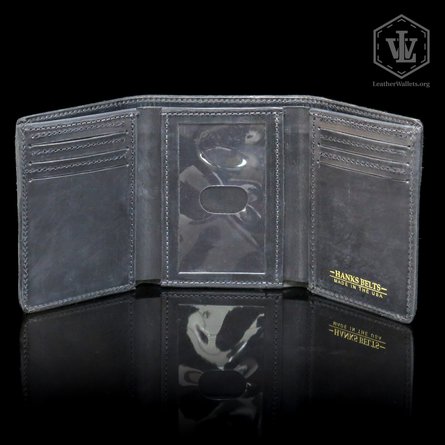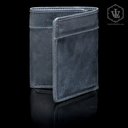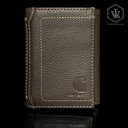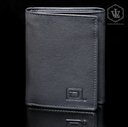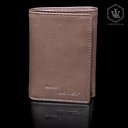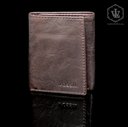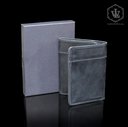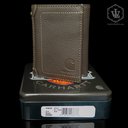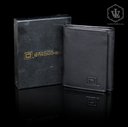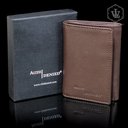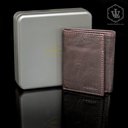Why Our #1 Pick is the Hanks Belts Trifold
The Hanks Belts Trifold is the best overall trifold we looked at for this comparison. The attention to detail is what struck me the most as I examined the wallet. For example, every spot where the stitching ends it is melted and balled to prevent it from fraying. Another great example is how the pocket slits include a small circle at each end to help preven the leather from continuing to split. The wallet uses a thick goat leather to provide a robust wallet that should last you an extremely long time.
How We Ranked Each Wallet
We purchased and performed a number of tests on each wallet.
Unboxing. First, we reviewed them for packaging: gift boxes, protective bags, shipping boxes, country of origin.
Leather and Stitching We took a close look at the materials used to construct the wallet. This includes the thickness of the leather, the type of stitching, and any other materials used including linings and backing material.
Construction. We examined them for physical materials and construction. Were they well-made? Were they susceptible to wear in certain places? How did they smell and feel?
Capacity. We tested each pocket and card slot to see exactly how many standard credit cards and paper bills each wallet would comfortably hold.
RFID protection. We tested each pocket of the wallets to see if a smartcard and a proximity card would scan through their lining. We tested them with separate radio frequency card readers that scan for 125 kHz (proximity cards) and 13.56 mHz (credit and other smart cards).
What to Consider when Deciding on a Trifold Wallet
What are the most important factors to you when picking out a new trifold wallet? Do you look for durable materials? Low prices? How much the wallet can hold? A certain style or color?
Here are our tips on how to select a trifold wallet with the best combination of features for your particular needs. We’ll present you with the information we’ve found so that you can make an informed buying decision.
Buying a new wallet is an opportunity to purchase something that will last for decades. High-quality will cost more than low, but you should never pay more than the materials and craftsmanship warrant. We don’t blame companies for trying to sell their products. We know that they have to put a positive spin on what they’re selling. That doesn’t mean that you have to take everything at face value though. We’ll show you what some common marketing terms actually mean, including warranty warning signs.
First, we’ll discuss how to tell the quality of the leather the wallet is made of (as well as a couple of other materials you might want to look into), and then focus on craftsmanship, the capacity that you might need in a wallet, some common features to look for or avoid, and finally the major pricing factors that should or should not affect the cost of a new trifold wallet.
Materials
Are you looking for a trifold wallet that will last a few years or a few decades? Not all wallets are the same, and the materials each wallet is made of are the biggest factors in how long it will last.
Here, we’ll give you some rules of thumb to help you evaluate the main materials of a wallet in person or when reading a product description online. In the next part, we’ll show you to evaluate the stitching and any plastic, clasps, pull-tabs, snaps, or other hardware that might be included in a trifold wallet.
Leather Quality
Do you know what the different grades of leather are? Most people don’t, and many companies are glad of it. The common lack of knowledge allows them to pass off products made of “genuine” leather as top-quality when they’re actually the lowest quality.
When you’re shopping for a leather wallet, the grade of leather that the manufacturer used is one of the most important factors regarding its durability. A wallet will be made of full-grain, top-grain, genuine, bonded, faux, koskin, or vegan leather. As you can tell, some of those descriptive words aren’t real leather at all. But let’s talk about the differences between all of these types of leather and leather imitations.
First, full and top-grain are the best grades of leather. They are extremely durable, lasting more than 100 years with minimal stretching. They’re both made from the top layers of animal hide. The difference is style.
Full-grain leather preserves the authentic appearance of the hide. If you buy a full-grain wallet, you’ll be able to see the natural markings from the animal’s skin. You’ll see birth marks. You’ll see where its skin changed colors with different spotting and patterns. You’ll see its unique pore pattern and where it was bit by mosquitos. You might see branding marks or injuries from its environment or herd mates. It’s rustic. Every piece of full-grain is unique and full of character.
But full-grain isn’t for everyone. Not everyone wants to see those natural markings and scars. That’s why leatherworkers make top-grain. It’s the same material as full-grain, but it’s sanded down to smooth and erase the marks and scars. It can be left smooth or embossed with a pore texture. When it is embossed, the texture and pattern will be uniform, unlike the diverse texture of full-grain. It creates a more fashionable type of leather for those who want a “cleaner” appearance.
Full-grain for rustic, top-grain for fashion. Do yourself a favor and don’t buy any wallet or leather good that doesn’t specifically say it’s made from one of these two materials. Here’s why.
Do you remember how we said that full and top-grain leather is made from the top layers of a hide? Genuine and bonded leather is made from the bottom layers. It’s often called split leather because the layers of this material are split from the top. These bottom layers are the same material that suede and nubuck are made out of. Would you trust suede to be sturdy enough to make a wallet out of? Of course not! It’s not a durable material. It’s easy to stain and ruin. You have to be careful with it and maintain it.
Wallet makers use the bottom layers because it’s less expensive and more plentiful than the top. To make it a little more durable, and to make it look like the top layers, they coat it with flexible polyurethane. They also might emboss it in the same manner other manufacturers might emboss top-grain. The polyurethane only adds a little durability to the split leather, though, because it won’t take long for the polyurethane to dry out. When it does, it will crack, and the leather underneath will start deteriorating. If a full or top-grain wallet could last for 100 years, how long do you expect a genuine leather wallet to last? We’re being generous when we say 5 years.
Bonded leather is worse. It’s nothing more than scraps of genuine leather! They glue or “bond” it back together and then coat it with the same crack-able polyurethane.
Genuine leather. It sounds as if the term simply means “real” leather, which it is in a sense. But what it should be called is “real bottom-layer leather.” And instead of bonded leather sounding as if it’s strong and durable, it should be called “scraps of leather.” But now that you know what these two grades of leather actually are, it doesn’t matter what they’re called. You know what they’re worth.
So, what about faux leather faux? First, let us just say that there’s nothing wrong with not wanting to carry around animal hide in your pocket. If you want to see yourself as being friendlier to the animals, we don’t have a problem with that. But from a durability standpoint, we wouldn’t recommend using faux, koskin, or vegan leather. All of those names are the same material. It’s nylon, polyester, or cotton coated with the same polyurethane as genuine or bonded leather. You would be much better off buying a nylon wallet that isn’t coated in polyurethane because then you wouldn’t have to deal with the polyurethane cracking after a couple of years.
The problem with genuine, bonded, and faux leather is that they are all imitations of top-layer leather. Imitations are never as good, and in this case, they’re very bad. They might look nice for a while, but they won’t last nearly as long. They’re also less expensive because they materials cost less, but is a wallet that you’ll have to throw away in five years worth buying? We would much rather spend a little more for a wallet that we probably won’t ever have to replace.
Now, what if the manufacturer doesn’t tell you the grade of leather they used? There’s only one reason they wouldn’t say, right? If they used full-grain or top-grain, they would want to tell you so that you knew you were getting high-quality leather. If they used faux leather, they would want to tell you so that you knew they shared your ideals. If they used genuine or bonded leather, they wouldn’t want to tell you because there’s no benefit to it other than being a cheap material. If the product description doesn’t say what type of leather the wallet is, it’s genuine or bonded. It qualifies as leather, but it’s very bad leather.
Of course, it doesn’t take a lot to see why full and top-grain wallets typically cost more than genuine, bonded, or faux. If a company supplies higher-quality, they can demand more for it. There are also fewer top layers that they can use, limiting their available supply of material. Cheaper wallets are cheaper because they’re made from cheap, abundant materials.
If materials were the only factor in pricing a trifold wallet, you could expect a full or top-grain wallet to cost in the $35-60 price range. Lesser-quality wallets shouldn’t cost more than $20.
Leather Tanning
After the grade of leather, a wallet maker might also tell you how the leather was tanned. Tanning is more than dyeing the leather. It’s the chemical process of preserving a hide. The hide of an animal isn’t leather until it’s been tanned.
The two oldest forms of tanning are brain tanning and vegetable tanning. Thankfully, no large companies use brain tanning. We doubt many people would want a brain-tanned leather wallet, and it’s not very economical. Vegetable-tanning isn’t the most economical choice, either, but it is widely used. It’s performed using plant-based extracts (tannins). It takes about 16 hours to tan a hide with plant tannins. When you do so, the end piece of leather is also very susceptible to water stains. Getting it wet results in permanent black watermarks.
The third method, discovered when medical professionals began soaking sutures in the material, is chromium tanning. Chrome-tanned leather also stains when wet but not as badly. It also takes half as long to tan a hide with chromium.
Water staining won’t affect the actual durability of the leather, but it will affect how long you might want to keep the wallet. Be careful not to get any leather wallet wet, and choose chrome-tanned leather for a little more protection against watermarking.
In this case, if a wallet manufacturer doesn’t advertise their tanning method, they’ve most likely used chromium since it is the faster process.
Leather Thickness
The tanning method, however, is not as important as how thick the leather is. A full piece of hide is very thick. No one could make a wallet from the full depth of a hide. It would be too thick to fold. Besides the fold, you also have to add pockets, adding to the overall thickness of the wallet. So wallet makers thin the leather. High-quality manufacturers use layers from the top of the hide while low-quality manufacturers use layers from the bottom of the hide.
You can’t thin the leather too much, though, or the material will be too flimsy. It will also wear through a lot faster than a thicker piece of material. So, how thick should a piece of leather be?
A good rule of thumb is that each layer of leather should be about as thick as a quarter. You can also test the thickness of the leather by standing it up and seeing if it stays uprights or not. If the material starts to bow or sag, it’s too thin. It can’t support its own weight.
But be careful. Just because a wallet stands up on its own doesn’t mean that it’s made of thick leather. Try pinching the layers to see if there’s anything in the lining of the wallet. Many times, a manufacturer who uses thin leather will prop it up with cardboard or plastic between the layers. Maybe they should call their wallets “leather and cardboard” instead of just leather, or “plastic-supported leather.”
Thankfully, manufacturers who use full and top-grain leather know enough not to thin the layer too much. Thinning the leather and using these types of inserts is another trick low-quality manufacturers use in their genuine and bonded leather products. It might add to the illusion of high-quality leather, but it only makes the product wear out faster. The thin leather rubs against the hard inserts, making the leather wear from the inside out.
We don’t recommend you doing this, but sometimes when we get a wallet we think is too thin, Trevor will actually cut it open to see what’s inside. Watch a few of the video reviews to see him do it.
Be aware that the thickness of the leather is another factor in the price of the wallet. Using more layers of a hide costs the wallet maker more in supplies, which will be passed on to you in form of a higher price. In exchange, you’re getting a wallet that will last much longer and feel better than a thin wallet.
Leather Scent
There are some smells that you can’t fake. The scent of leather is one of them. But you can mask its scent with polyurethane and other heavy finishes. If a wallet looks good, smell it. If you smell more chemicals than leather, the wallet is probably made of genuine or bonded leather. The coating overpowers the smell of the leather.
If you smell clean leather, you’re most likely looking at full or top-grain leather. They don’t need thick finishes to be durable or look attractive. And they’ll continue smelling the way they for the life of the wallet. The smell of leather doesn’t go away as you handle it.
What if the wallet doesn’t smell at all? If you don’t pick up any scent, it’s either not leather, or it is leather that has been so coated as to not emit a leather scent. It would emit chemical smells, but it’s been sitting in a store or warehouse long enough that the chemical odors have dissipated.
Leather Feel
Like the smell of leather, you can’t fake the feel, but you can cover it up. Those same heavy finishes that mask the scent will make the wallet feel like plastic or wax. When you run your hand over a high-quality wallet, you should feel the grain of the hide. It won’t be rough, but there should be some texture, even in top-grain wallets that have been sanded down.
If you can’t tell that it’s leather versus plastic, it might as well not be leather. The leather needs to be more than the base material. You need to be able to smell and feel it beneath any surface finishes.
Leather Quality Summary
So, if you’re looking for a leather trifold wallet, what should you be looking for? We recommend full or top-grain, depending on your style, that has been tanned with chromium and not so heavily finished that you can’t smell or feel the leather. If you can find a wallet with those characteristics, you’re on the right track. If you’re looking at a wallet with all of those characteristics except for the fact that it was vegetable-tanned, it will still make a very durable wallet. Just be careful in the rain.
Nylon
You might also want to look into other materials besides leather. Nylon is a very durable material for wallets.
But isn’t nylon a plastic? And didn’t we say that a wallet shouldn’t feel like plastic?
Well, we said that a leather wallet shouldn’t feel like plastic. A plastic wallet can feel like plastic with no problem. But it’s not for everyone. Nylon isn’t as stylish as leather. It’s not as classic as leather.
But nylon is flexible and durable. Nylon wallets also don’t stain when they get wet. Many men who carry a leather wallet for everyday use also have a nylon wallet for playing sports. They’re usually bifold, but you can find a few trifold nylon wallets if you’re interested.
Nylon wallets are also less expensive than their full or top-grain leather counterparts. The material is synthetic and easily shaped. A nylon wallet will cost about the same as a genuine or bonded leather wallet without the reduced durability.
Construction
We’ve been recommending full and top-grain leather wallets, and nylon wallets as an alternative, but there is a limit to how long these high-quality wallets will last. Wallets using the best primary materials can be ruined by the secondary materials that go into a wallet: stitching, plastic windows, snaps, cash pocket zippers, and other components.
Let’s take a look at some of the most common secondary materials that will or might be included in a trifold wallet.
Stitching
Every leather or nylon wallet should be held together by strong stitching, not glue. Wallets held together with glue might look interesting, but the panels will start pulling apart as soon as you start using it. Any type of bonding material is best used when the object it’s holding stays still. A wallet that has to flex isn’t a good candidate for being held together by glue.
The best materials for stitching are nylon and polycarbonate. These materials are strong, durable, and won’t be damaged in water. The highest-quality wallets will use one of these two materials. Cotton is a third alternative. Cotton threads are not as durable, but they are less expensive.
The stitching can be made much more durable, however, when it is reinforced. Even nylon and polyester threads should be reinforced with double-stitched lines or a cross-stitched pattern. The outer line reinforces the inner line in a double-stitched pattern as the wallet’s pockets flex in and out with cards or cash.
Double-stitching is a subtle pattern that most high-quality manufacturers use. Cross-stitching is more of an obvious pattern and is used to add to the style of certain wallets. It presents more of a homemade appeal and can be a good look for rustic selections.
You’ll also want to look at how the stitching is finished. When you look on the inside flaps of the wallets, does the stitching make a knot at the end? Does it loop around into a part of the pattern below the end? Or are the ends cut and melted together?
The last choice is best. Melting the ends together prevents the threads from coming loose as each thread is held tightly in place by the others. With any other finishing method, the threads could come loose at the end, eventually loosening the construction of the entire wallet.
Lining
The other secondary but necessary material that a trifold wallet will have is the lining for the pockets. You can make the lining out of any material, but the most common choices are pigskin, suede, polyester, nylon, cotton, and silk.
Silk lining sounds nice, doesn’t it? But what happens when a card with a rough edge slides against silk lining? I can almost hear the fabric tearing now. It would tear nearly as easily if it were made of cotton. Polyester is stronger with nylon being even better. Of course, if we’re talking about leather wallets, the best materials are smooth pigskin or suede.
Suede is that “genuine” leather material we wanted everyone to throw away. But, again, we only despise its use when it used in place of the more durable full and top-grain leathers. Using it as the lining of the pocket is a perfect choice! It’s protected from exterior wear and doesn’t need to be coated with additional chemicals.
Pay attention to the stitching along the sides of the lining, however. The stitches should never cross the lining where a card could snag the threads or extend from the side of the pocket into the slot space where it could obstruct cards sliding into it. Not only would it be aggravating to try to use the pockets but the cards would snag and pull the threads.
Snaps and Chain Rings
Some trifold wallets snap shut. Others have chain rings to keep your wallet secure.
Test the snaps to see how tightly it connects. Does it take some force to pull it apart again? You don’t want it to be a struggle, but it should be tight enough that it’s not going to come open just from moving around in your pocket. Snaps also need to be securely fastened to the wallet. No matter how securely the snap connects, it will be ruined if it pulls free from the leather or nylon.
Chain rings should not be at the edge of the flap. They should have enough material surrounding it that the wallet can support the chain ring when the chain pulls on it. The leather should be double-stitched around the chain ring to ensure that the material doesn’t rip or loosen, allowing the chain ring to fall out of the hole. The chain ring itself should have a thick, wide metal lip surrounding the leather on both sides of the flap to hold it in place.
Zippers
Trifold wallets can also have zippers for cash, coin, or hidden pockets. They’re a great way to secure your belongings provided the teeth make a strong enough connection and the fabric is sewn to withstand frequent use.
Zippers should zip all the way to end, closing the entire pocket with no open teeth at the top of the zipper. If it doesn’t zip shut all the way, open teeth can stretch open and cause the zipper to slide down even further. It should also take some force to open or close the zipper, showing that the teeth are making strong connections and not ready to open with a gentle slide of the handle.
The stitching along the fabric of the zipper should be tightly double-stitched. You’ll be pulling on the zipper frequently to open and close the pocket, so it the threads will need to be able to withstand the stress.
Plastic and Elastic
Most trifold wallets have plastic ID windows or plastic card and picture inserts. The plastic used for these purposes is not very strong. It’s susceptible to denting, scratching, and cracking. Try to find a wallet with an ID window that doesn’t use plastic and instead features a window with a recessed opening cut out of the plastic. Or make sure that the trifold wallet you buy has the ID window on the interior fold of the wallet, not the outside, so that it will be more protected from wear and tear.
Plastic inserts are even less durable, but they’re usually replaceable. If you want a wallet with card and picture inserts, make sure that you can take them out and slide another set into its place.
A trifold wallet might also use an elastic band to keep it closed, to store quick-access cards, or to retrieve a stack of cards out of an inner pocket with a pull-tab. We won’t argue the usefulness of such features, but we will caution you as to their longevity. Elastic stretches. The fabric frays. An elastic band won’t hold anything closed or in place once it stretches out. A pull-tab that breaks makes the pocket it supports virtually unusable.
Craftsmanship
The craftsmanship of the wallet has less to do with the materials a company uses and more to do with how well the wallet is put together. Is it machine-made or handmade? Do the wallet makers take pride in their work or do they rush as many wallets out the door as possible? You can tell the difference by looking at how straight the cuts and angles are and how well the edges and corners are finished. Here’s what to look for.
Cuts and Lines
Each cut and angle should be straight and parallel or perpendicular to the rest of the lines of the wallet. Fabric should be cut evenly across and stitching lines should appear straight with even spacing. You don’t want to see a dotted line where the dots aren’t all the same length or the same length apart.
Pocket Edges
Take a look at the tops of the pockets. If the material is cut off at the top, ensure that the pocket is thick enough not to droop in. It should stay rigid whether a card is in the pocket or not.
If the pocket folds over, look down the inside of the pocket and make sure that the folded material goes all the way down to the bottom. You don’t want a fold that creates a lip for the cards to catch on. It will be mighty aggravating pulling cards out past the lip, and besides that, the wear will loosen the threads of the fold over.
You might also see a rolled seem on the front of the pocket. When done right, this is a sign of a very high-quality wallet. When done wrong, it’s a sign of a low-quality wallet trying to look high-quality. The way you can tell the difference is by feeling the thickness of the leather below the fold. If it’s too thin, the rollover was easy to do and simply shows that the pocket should have been made thicker. If the pocket feels thick further down, the wallet maker had to thin the material at the top by hand to accomplish the curve. Only the highest-quality wallets have thick pockets and rolled edges.
Wallet Edges
Next, check the edges of the wallet itself. Do you see where the material was cut or does it fold it so that you can’t see it? Wallets with cut edges might look neat for homemade projects, but they show poor craftsmanship from a company. The edges should be turned in to add durability and a finished look.
Are the edges smooth all the way down the wallet with all of the layers and pockets blending together? Or does the edge of the wallet look like a flight of stairs with each layer adding a step?
High-quality wallets have thinned edges to make a smooth surface. One trick to make a non-thinned or non-turned edge look better is to coat it with resin. And you know how we feel about coating leather. It’s a shortcut that won’t last. Just like polyurethane, the resin coating will crack and peel off piece by piece, exposing the edge it was mean to cover sooner rather than later.
Edges should be turned in and thinned to create a smooth surface.
Corners
Following the edge up and down to the corners, make sure that the edges are rounded off. Square corners crumple and fold in on themselves sliding in and out of your wallet. They become a weak point in the construction. Rounded corners slip in and out without getting caught on your pocket.
If you look at how the corners were sewn, you should see the fabric bunched up, like the fabric of a curtain does when it’s open. This is called pleated corners. It shows that the wallet maker did not cut off any of the corner material when the rounded it. It will be stronger than cut corners because they didn’t cut corners making it.
Warranty
You can also tell a lot about how long a wallet will last by noticing how long the warranty is. Beware of manufacturers that only offer warranties for a few months. They’re basically telling you that the wallet won’t last much longer than and that they don’t want to be held responsible when it starts falling apart.
“No questions asked” money-back guarantees are another warning sign. When they say they won’t ask questions when you demand a refund, they’re also hoping that you won’t ask questions about the quality of the wallet. “Don’t ask, don’t tell” might be a good policy in some situations, but it doesn’t do the consumer any good when shopping for a product.
We would much rather see a warranty that lasts 1, 2, or 3 years. That long of a timeframe gives the buyer enough time to use the wallet and see that it will last. If the wallet does happen to have a mistake in stitching or some other defect in materials or craftsmanship, it will show up in that amount of time, and you can have the wallet repaired or replaced at no cost to you. It also lets the company off the hook after a reasonable amount of time. If they’re wallet holds up for a couple of years with no major signs of wear, they’ve proven its quality and can consider the sale final.
On the extreme end of warranties, you’ll see some companies offering to stand behind their wallets for a hundred years. I’m glad that they’re confident in their product, but a warranty more than a few years just feels like marketing. Am I really going to send them my wallet in 20 years? I doubt it, and so do they.
Our recommendation is to look for warranties that last at least a year and don’t be swayed by extremely long warranties. Products from such companies won’t be of any higher quality than those with more reasonable terms.
Size and Weight
A trifold wallet obviously opens larger than a bifold, but it doesn’t need to be any larger when closed. A trifold wallet should measure about 4.5 inches tall by 3.5 inches wide. With those measurements, you can easily slide your bills into the cash pocket and have plenty of room for vertical card slots in the interior. It will slide easily into your back pocket and you can even use it as a front-pocket wallet if you don’t mind it being a little thicker for the extra flap.
A trifold leather wallet of proper thickness should weigh between 75 and 125 grams.
Any wallet larger than 4.5” x 3.5” or heavier than 125 grams will be a little difficult to fit in your pocket and will make your pants sag.
Capacity
Now we’re getting into the realm of preferences versus quality. We assume, though, that if you’re shopping for a trifold wallet, you want a wallet with a lot of carrying capacity. Before you buy, test the wallet. Put as many bills as you normally carry in the wallet. Fill the pockets with your cards. Feel how tight the pockets are and test how easy it is to slide your cards in and out.
In our review videos, you’ll see Trevor fill each wallet to determine how much they can handle.
You’ll also want to pay special attention to the layout of the pockets. Will you find the design easy to use and convenient or will the layout be a hassle? Think about how often you need to show your ID or how often you might need to pull cards out of a pull-tab pocket.
Envisioning how you will use the wallet and testing its capacity will help you determine how well each model will meet your needs.
Features
Maybe you want the pull-tab and card inserts. Maybe you need snaps and zippers and chain rings. Maybe you need a coin pouch and a mini pocket for your SIM card.
Browse a few wallets, determine which features you like (keeping in mind how durable those features will be), and shop until you find the wallet that has everything you’re looking for. With so many wallet makers making so many models of wallet, there’s no reason to settle for the common trifold.
RFID Protection
One feature that we would encourage you to add to your list is RFID protection. Modern credit, bank, and pass cards are read via radio frequencies. Card readers emit a frequency that passes through the card and interprets the data.
The problem is that you don’t have to insert your bank card into a reader or hold your pass card up to a door panel for someone to read the information. People can scan your data from a distance while your cards are in your wallet in your pocket.
How do you protect yourself from identity theft, unauthorized purchases, and illegal entry? You make sure the wallet you buy features radio frequency identification (RFID) blocking material. It’s metallic material inserted behind the lining of your wallet or in each pocket. Some wallets block only bank card and similar scans (encoded at 13.56 MHz) while others also block pass card scans (encoded at 124 kHz). You can even find wallets that have protection in some pockets but not others so that you can you use your EZ pass cards as you like.
You can also purchase RFID blocking sleeves for your cards if the wallet you want doesn’t have RFID protection. The sleeves are a little cumbersome to use, though, as they create a pocket within a pocket and reduce how many cards you can actually fit in your wallet with their added thickness.
Design
If you like the brand that makes a particular wallet, you might also like their logo and appreciate the ability to have it stamped prominently on your wallet. Others couldn’t care less about brand names and don’t want a large design or logo. The choice is up to you, but if you do buy a wallet with a logo or other type of design, think about how long you will continue to like it. The brand might go out of fashion or the design might seem out of date long before you would need to replace the wallet.
Purchase Options
Everyone like brown and black leather, right? They’re classic colors, but there’s no reason leather or nylon can’t be any color you want. Many companies offer a variety of colors for each model. Look for a model with a color that appeals to you. But, again, think about whether you’ll continue liking that color for the life of the wallet. Also, think about whether you’ll feel comfortable using that color of wallet in front of your boss versus just your friends.
Packaging and Gift Boxes
When you’re buying a trifold wallet online, ensure that the seller packages it correctly. It should come in its own individual box with plenty of packing material surrounding it in a larger shipping container. This double packaging will protect it from being scratched or punctured before it gets to you.
Many manufacturers also offer gift boxes with their wallets. But if you’re buying a wallet as a gift, try to find pictures of what the gift box looks like. What some companies call a gift box is what we would call a shipping box. You can wrap it, but you would never present the gift in the box alone. Other wallet makers send you proper gift boxes inside a shipping box in inside a larger container. They’re decorative and help to show the value of the present you’re giving to someone. You don’t need to wrap a box like that.
Price
How much should you pay for a high-quality trifold wallet? We said earlier that the leather for a full-grain or top-grain wallet would place it in the $35-60 category. But then you have to add the value of the secondary materials, the skilled craftsmanship that went into assembling the wallet, the design features, and the branding.
Actually, let’s leave the branding out. Who makes the wallet shouldn’t have any bearing on the price. You can find high-quality wallets with all of the features you want at much lower prices than big brands. They’ll last just as long and perform just as well, so why pay more for a company name?
A fair price for a trifold wallet is $40-75. Some of those we’ve listed are great deals for less. If you see any trifold wallets priced below $25, beware. They’re probably made from genuine or bonded leather with lots of shortcuts taken in the craftsmanship. They might look great in the pictures but won’t last more than a couple of years in real life.
Conclusion
If you’re in the market for a trifold wallet with vertical pockets, this article hopefully gave you a good selection of wallets to choose from, and a solid base of information on each. Best of luck in your search. It’s my hope that the information in this article helps you choose a wallet that is a worthy partner to you for many years (if not decades) to come.
Have a wallet that you think should be included? Be sure to send me a note using the contact form!
